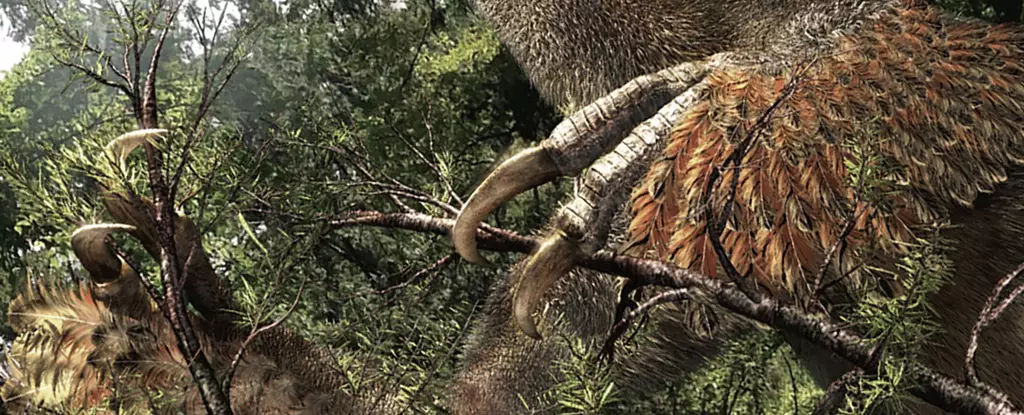The recent discovery of Duonychus tsogtbaatari, an extraordinary feathered dinosaur with astoundingly preserved two-fingered hands, is shaking the very foundations of paleontology. Having emerged from the Cretaceous sedimentary layers of Mongolia’s Gobi Desert, this remarkable specimen is not just another dinosaur—it is a game-changer. The implications of its findings extend far beyond the paleontological community and offer an opportunity to reconsider evolutionary paradigms about the therizinosaurus group and their adaptations.
Among its most striking features, Duonychus flaunts gigantic, claw-like talons that have surely earned the admiration of both scientists and enthusiasts alike. With claws measuring an imposing 30 centimeters (about 12 inches), they hint at a fascinating evolutionary narrative that challenges our assumptions about dinosaur morphology. The genus name, deriving from Greek, aptly translates to “two claws,” which sets the stage for exciting new hypotheses regarding hand function and evolution among theropods.
The Context of Discovery
Unearthed in a region recognized for its wealth of dinosaur relics, the Bayanshiree Formation is a treasure trove of ancient biodiversity. Given that this area has already yielded colossal footprints and massive pterosaurs, researchers at the Mongolian Academy of Sciences were not entirely surprised to find Duonychus. Yet, the distinction of discovering the first therizinosaur with only two fingers makes this fossil find particularly riveting. After years of digging, it represents an archeological highlight that could not only rewrite the evolutionary history of therizinosaurs but also prompt introspection among researchers about what defines a successful species.
The collaborative effort to excavate and analyze this fossil has involved careful uranium-lead dating, suggesting it hails from around 90 to 95 million years ago. Such techniques are crucial for placing Duonychus within the broader timeline of life on Earth and shedding light on its environmental context, which may have influenced its anatomical adaptations significantly.
Challenging Evolutionary Norms
Before Duonychus was discovered, therizinosaurs were well-known for their three-fingered hands—an evolutionary standard that had remained unchallenged. The realization that a species could thrive with only two functional digits invites critical inquiry into how adaptations manifest in response to environmental pressures. Experts like Kobayashi have emphasized that the anatomical variations observed in Duonychus are particularly important in understanding feeding strategies among herbivorous theropods.
The gripping, sloth-like claws suggest a grazing mechanism that enhances their ability to pull food toward their mouths. This new evidence compels us to consider that evolutionary success is not a monolithic path of incremental changes but rather a complex interplay of factors leading to unexpected specializations.
Beyond Feeding: Dual Functions of Claws
The researchers have posited that while the primary function of claws often hinges on foraging, additional roles should not be overlooked. Claws may also serve functions in territoriality, defense, courtship, or even playful interactions among these ancient giants. This multiplicity of utility further enriches our understanding of how dinosaurs operated within their ecosystems.
Imagine the ecological dynamics—Duonychus feeding on foliage while simultaneously using its impressive claws for various interactions with its peers. Such dual functions could have offered it an evolutionary edge in an environment teeming with competition. The understanding that tools and features can serve multiple roles is an idea so prevalent in the animal kingdom today, but it is refreshing to trace its origins back this far in our evolutionary history.
The Future of Paleontology
The discovery of Duonychus tsogtbaatari signals not only a pivotal moment in understanding dinosaur evolution but also the necessity for continued exploration and open-mindedness within paleontological research. The field must remain adaptable, as unexpected finds like this illustrate that the past may be even more convoluted than previously believed. This encourages us to keep searching for fossils that may provide even deeper insights, as well as to reevaluate existing categorizations and definitions in light of new evidence.
As we stand on the cusp of new discoveries, it is vital that we harness the spirit of curiosity that drove the researchers to excavate in the unforgiving Gobi Desert. The story of Duonychus is a clarion call for more comprehensive studies, dismantling the conservative boundaries of dinosaur classification and urging a broader understanding of life’s evolutionary tapestry.


Leave a Reply